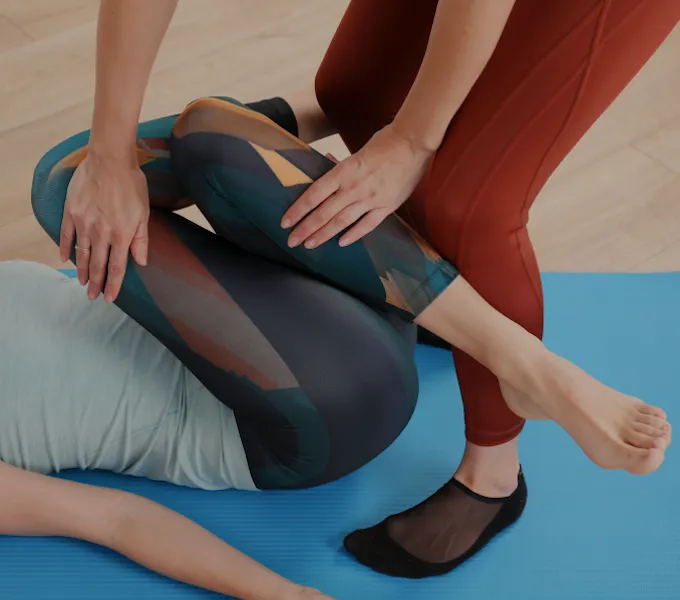
Peeing When You Laugh is 1 of 3 Types of Urinary Incontinence
Leaking urine when you sneeze, cough, or bust out laughing — aka stress urinary incontinence (SUI) — may be the best known form of urinary incontinence, but it isn't the only one. To put it in terms of celebrity siblings, SUI is the Chris Hemsworth of urinary incontinence, and we're here to tell you a little more about Luke and Liam. Getting familiar with all 3 types will help you better understand your symptoms, what may be causing them, and how a physical therapist can help.
Before we get to it, it's important to know that urinary incontinence of any kind isn't likely to go away on its own. It may also worsen through different life stages, for example with each pregnancy, in postpartum, and in menopause. So, if your bladder leaks, don't wait. See a pelvic floor physical therapist to start treatment, ASAP.
The 3 Types of Urinary Incontinence
The popular one: Stress urinary incontinence (SUI)
This is the urinary incontinence that most of us are familiar with — the "don't make me laugh, I'll pee my pants" variety. Technically, it's defined as an involuntary loss of urine due to an increase in intra abdominal pressure (more on what that means below).
Symptoms: SUI can cause you to lose any amount of urine, from a drop to a bladderful. With SUI, leakage occurs when you laugh, sneeze, cough, jump, or do anything physical that increases internal pressure on your abdominals. That pressure translates to pressure on your bladder, which forces urine out.
Causes: Leaks happen when your pelvic floor muscles aren’t strong enough, or quick enough, to counteract the intra abdominal pressure and support your bladder or urethra. There may also be increased movement or 'hypermobility' in your urethra or bladder. Normally, the connective tissue that surrounds and supports the bladder and urethra allows for very little movement. But if your pelvic floor is injured, for example during a vaginal delivery, there may be excessive movement of the bladder or urethra, which makes it easier for urine to sneak out.
Treatment: When your pelvic floor muscles are slacking on the job, the goal in physical therapy is to get them back to work. This looks different for everyone, but specific exercises are provided to get the proper range of motion, power, endurance, and timing of your muscles to protect against increases in intra abdominal pressure. We’ll also check in on your bladder habits, hydration, and diet to reveal — and make a plan to improve — any factors that may be contributing to leakage.
The Speed Demon: Urge Urinary Incontinence (UUI)
This is the "when you've gotta go, you've really gotta go" type of urinary incontinence. Or, more officially, leakage that occurs after a sudden and strong urge to use the restroom.
Symptoms: You may experience leakage as you rush to the bathroom, or even before you have a chance to take a step in that general direction.
Causes: To understand UUI, you have to know a little about the detrusor muscle, which is the muscle that makes up the walls of the bladder. Here's how the detrusor should work: Your bladder feels full, so you head to the bathroom. Once you're sitting comfortably on the toilet with your pelvic floor muscles relaxed, your central nervous system lets your detrusor know that it's time to contract. When it contracts, urine flows. With UUI, your central nervous system is signaling the detrusor to contract at inappropriate times. This can happen in response to psychological triggers like hearing running water or putting your key in the door when you get home from work — suddenly you have to race to the bathroom or risk peeing your pants.
UUI can also be linked to physical trigger points — small, highly irritable knots of muscle — often located in the inner thighs or pelvic floors muscles that can refer pain to the bladder. Research shows that manual physical therapy to treat these trigger points can help ease symptoms.
Treatment: A pelvic floor physical therapist will check in on your bladder habits, as well as hydration and other dietary factors that could be making leakage worse. They'll teach you techniques to help suppress urges and retrain your bladder. If appropriate, they'll use manual therapy to release any physical trigger points. The end-goal: Get your detrusor working normally again.
The Complicated One: Mixed urinary incontinence (MUI)
You guessed it, mixed urinary incontinence is a combination of stress urinary incontinence and urge urinary incontinence. That means your bladder can leak with increased intra abdominal pressure and you'll feel an urgency to go that's so strong, you can't always make it to the bathroom on time. Symptoms and causes are as described above, and treatment will include strategies to tackle both types of incontinence.
At Origin we'll treat your specific type of incontinence at a pace that feels comfortable for you. For most patients, positive results can be seen after just 1-3 visits, as you connect with your body and learn strategies to manage symptoms. After a few months of steady physical therapy, you'll be able to get back to a life that's blissfully free of bladder leaks. Even better, you'll have have a toolbox full of expert tips and strategies to help prevent all three types of urinary incontinence, for decades to come.



